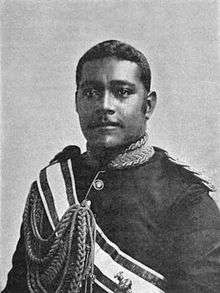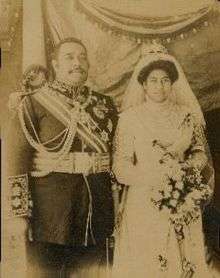George Tupou II
| Siaosi Tupou II | |
|---|---|
| King of Tonga | |
 | |
| Reign | 18 February 1893 – 17 July 1918 |
| Coronation | 17 July 1893, Nukuʻalofa |
| Predecessor | Siaosi Tupou I |
| Successor | Sālote Tupou III |
| Born |
18 June 1874 Neiafu, Tonga |
| Died |
5 April 1918 (aged 43) Tonga |
| Burial | Malaʻekula |
| Spouse |
Lavinia Veiongo ʻAnaseini Takipō |
| Issue |
Sālote Mafile‘o Pilolevu ʻElisiva Fusipala Taukiʻonelua ʻElisiva Fusipala Taukiʻonetuku |
| House | Tupou |
| Father | Tuʻi Pelehake (Fatafehi Toutaitokotaha) |
| Mother | ʻElisiva Fusipala Taukiʻonetuku |
| Religion | Free Church of Tonga |
Siaosi Tupou II, King of Tonga (George Tupou II in English; 18 June 1874 – 5 April 1918) was the King of Tonga from 18 February 1893 until his death. He was officially crowned at Nukuʻalofa, on 17 March 1893. He was also the 20th Tuʻi Kanokupolu. In Tonga itself he was better known under the Tongan version of his name Jiaoji Tubou (Siaosi Tupou in modern spelling) or even Tāufaʻāhau Tupou II.
Life
Siaosi Tupou II was the son of Prince Tuʻi Pelehake (Fatafehi Toutaitokotaha) also Prime Minister of Tonga in 1905), whose mother Sālote Pilolevu was a daughter of Tāufaʻāhau Tupou I, and he was the son of Fusipala Taukiʻonetuku, a daughter of Tēvita ʻUnga who was a son of Tāufaʻāhau Tupou I again: George Tupou I that is, the founder of the united Tongan kingdom. Tupou II's reign was troubled by government corruption and inefficiency. The Tongan Parliament in 1900 was suspicious of the King's governing and had his accounts audited several times, finding discrepancies worth thousands of pounds. The expatriate community in Tonga called for its annexation to New Zealand.[1] Still he was a gentle person, a doting father to his daughter Sālote. However before he was married to Lavinia, he had an intimate relationship with Margaret Cocker (English missionary) who had two children Uaia and Ana Fakalelu kihe fana. These two children were kept a secret due to the implications of the King having relations with a commoner from England. Uaia continued to live in the palace while his sister Ana was entrusted into the care of a chieftain of Uiha Malupo (Takapautolo). An artist who wrote songs and poems this in he had much in common with his earlier Hawaiʻian colleague Kalakaua. He is also known for his push to construct cement water tanks (vaisima) everywhere in Tonga, providing clean water to the people, which was a major boost to public health.

He ascended the throne at the age of 18, upon the death of his great-grandfather George Tupou I, at which time he was still a bachelor. In 1896, the chiefs of the country urged him to marry and produce an heir. After her death, the chiefs suggested a new wife, ʻOfa-ki-Vavaʻu, the daughter of Māʻatu from Niuatoputapu, who was related to the Tuʻi Haʻatakalaua line. George, however, refused. Instead, on 1 June 1899, he took Lavinia Veiongo (1879–1902) as wife. She was the daughter of Kupuavanua from Vavaʻu and Tōkanga from Niuafoʻou, thus obliging these islands to the throne. Kupuavanua was also, through his mother Lavinia Veiongo (1828–1907), a grandson of the last Tuʻi Tonga Laufilitonga, thus enabling him to claim rights to that line as well. Nevertheless, the marriage almost started a civil war. For years, relations between the king and the rest of the country remained strained. In addition to his inept governance, so different from that of his great-grandfather, this on-going strain led in 1905 to Tonga's becoming a British protectorate.

Queen Lavinia died on 25 April 1902 from tuberculosis, leaving one child, Sālote (born 13 March 1900). She was not popular, as she was perceived as being born from the 'wrong' mother; so much so that it was not safe for her to go outside the palace garden. When Siaosi married for the second time, on 11 November 1909, to the then 16-year-old ʻAnaseini Takipō Afuha'amango, a half sister of the rejected ʻOfakivava'u, the chiefs were jubilant. It was customary in old Polynesia for a defeated chief either to be killed or to be exiled. As such, it was a fortunate excuse that Sālote had to go to school in Auckland that she could be put on the December steamer to New Zealand. Queen Anaseini Takipō was the daughter of Honourable Siosi'ana Tongovua Tae Manusa and Tevita Ula Afuha'amango. Tae Manusa was the highest ranking woman in Tonga after the death of the last Tamahā because of the strong bloodlines she had coming directly from Tu'iHa'atakalaua and Tu'iKanokupolu her daughters made the perfect option for Tupou II to marry. Tae Manusa was the daughter of Honourable Reverend Penisimani Latuselu Kaho and his wife (Also his first cousin) Honourable Ilaisa'ane Tupou'ahau (daughter of His Highness Maealiuaki Fatukimotulalo Tu'iHa'atakalaua). Penisimani Latuselu was also the son of Honourable Nunufa'ikea Tuita and Her Royal Highness Princess Paluleleva Mulikiha'amea (Sister of Maealiuaki and the Mehekitanga of Tupou'ahau). Both Nunufa'ikea and Paluleleva were both Great Grandchildren of His Highness King Ma'afu'o'Tu'itonga Tu'iKanokupolu. That is why both Ofakivava'u and Takipō were the most suitable brides for His Majesty King George Tupou II.
Sālote would remain in exile for 5 years, although she did come home during some Christmas holidays. After December 1914 her father ordered her to stay home. Queen Takipō had still not brought forth a son. Her first daughter, ʻOnelua (born 20 March 1911), died of convulsions aged six months, on 19 August 1911;[2] her second daughter, ʻElisiva Fusipala Taukiʻonetuku (born 26 July 1912), was still alive, but was a girl too (she eventually died from tubercular peritonitis on 21 April 1933 aged 20).[2] The hope the envying chiefs had had on an heir through Takipō was fading, and Sālote's supporters' hope rose. The need to find a politically acceptable husband for her became acute, and he was found in the end in Tungī Mailefihi, cousin of ʻOfa. If there was any action by Siaosi Tupou II that left a positive and enduring legacy to Tonga, then it was this arrangement of his daughter's wedding.
Siaosi had also a few children from other women. Some of these descendants are now prominent politicians in Fiji, and others still highranking chiefs in Tonga itself (Vīlai Tupou, father of Baron Vaea). His own government, on the other hand, was an absolute mess and some ministers were seriously contemplating to ask the British to annex the country. This would perhaps have happened, had the king not become ill, and at the end died. He was soon followed by his wife Takipō (1 March 1893 – 26 November 1918) from the infamous Spanish flu epidemic raging in Tonga. Siaosi's daughter succeeded him and would drag Tonga out of the mire it was in.
Honours
He was Grand Master of the Royal Orders of Tonga that he founded:
 The Royal Order of Pouono (founded in 1893)
The Royal Order of Pouono (founded in 1893) The Royal Order of King George Tupou I (founded ca. in 1876–90)
The Royal Order of King George Tupou I (founded ca. in 1876–90) The Royal Order of the Crown of Tonga (founded in 1913)
The Royal Order of the Crown of Tonga (founded in 1913)
References
- ↑ Campbell, I.C (2001). Island Kingdom: Tonga Ancient and Modern. Christchurch, New Zealand: Canterbury University Press. p. 134. ISBN 0-908812-96-5.
- 1 2 royalark.net: Tonga royal genealogy [retrieved 15 December 2015].
- A.L. Kaeppler, M. Taumoefolau, N. Tukuʻaho, E. Wood-Ellem; Songs and poems of Queen Sālote; 2004; ISBN 978-982-213-008-9
External links
 Media related to George Tupou II at Wikimedia Commons
Media related to George Tupou II at Wikimedia Commons
| Regnal titles | ||
|---|---|---|
| Preceded by George Tupou I |
King of Tonga 1893–1918 |
Succeeded by Sālote Tupou III |